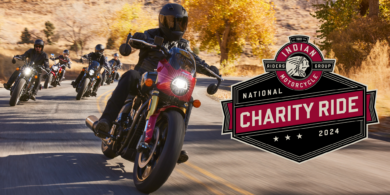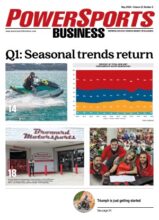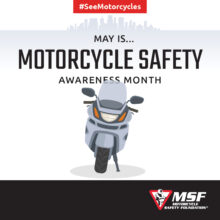Dealers eager for MuZ model 1000
Ray Campanile admits that he wasn’t sure what he was in for when Germany-based Motorrad- und Zweiradwerk GmbH (MuZ) began sending his Florida-based import and distribution company scooters and youth-sized ATVs in addition to the traditional fare of MuZ-branded street and dual-purpose motorcycles.
Campanile, president of Motorrad of North America, now explains away the latest MuZ reincarnation as “kind of a survival thing,” and says the changes happened because the company just couldn’t move enough motorcycles.
While Campanile may lament about some of the product currently being offered from the manufacturer, he — along with the 300 dealers his firm serves — could find solace in knowing a bigger, stronger, MuZ motorcycle is on its way.
“The 1000s is going to change everything,” Campanile told Powersports Business, referring to the super sport model MuZ has promised for a couple years, but which now is scheduled for a 2003 U.S. debut.
The 1000s will be powered by a proprietary 998cc, DOHC, eight-valve engine; weigh 210kg; and is expected to speed to 60 mph in 3.4 sec.
“Its appeared at a couple of shows,” Campanile said, “but we’ll finally be seeing it here sometime later this year.”
Company History
Campanile has headed the importation of MuZ bikes since his days with Jawa America. He began working for Jawa in 1989 and, in 1992, saw an ad for a 500cc Silver Star Classic he now says immediately attracted him to the MuZ brand.
An importer and distributor of mopeds, sidecars and CZ cycles, American Jawa then became the importer of MuZ product from 1993 until bankruptcy shut down the company in 1997. Thereafter, in April 1997, Campanile opened Motorrad of America in Daytona Beach in an effort to serve MuZ directly.
Historically a German company, MuZ has been owned by Malaysian conglomerate Hong Leong Industries since September 1996, after the previous owner — Petr-Karel Korous — filed for bankruptcy in April of the same year.
While the company receives its operating capital and scooters and ATVs from Asia, MuZ motorcycles continue to be built in a facility in Zschopau, Germany, a city hidden behind the Iron Curtain for over 30 years (see MuZ Timeline below).
Product Line
MuZ’s venerable Skorpion model of motorcycle — powered by a 660cc Yamaha engine and available in three configurations — ended its eight-year U.S. sales run in 2002, but the company failed to replace the mid-class bike with an equal or larger model and instead chose a path consisting of three 660cc dual-purpose bikes; German-made 125cc MuZ street, off-road and dual-purpose bikes; and the Malaysian-built scooters and quads.
Motorrad’s 300-dealer distribution channel is made up of various types of retailer: ATV only, scooter only, motorcycle only, and those carrying the full line.
The company currently backs 81 motorcycle dealers, yet Campanile, planning for the launch of the 1000s, says he would like to take on a total of about 120 before the end of the year.
MuZ TIMELINE
1906: Dane Jörgen Skafte Rasmussen buys an empty textile factory in Zschopau and aims to produce household and workshop appliances as well as automotive fittings.
1917: The business, now named Zschopauer Maschinen-fabrik J.S. Rasmussen, attempts to design a steam-driven automobile, but fails. Nevertheless, the brand DKW (Dampf Kraft Wagen, or Steam Automobile) is born.
1920: A single-horsepower auxiliary engine for bicycles is developed.
1922: Actual motorcycle production begins in Zschopau with a148cc two-stroke engine delivering 2.5 hp.
1924: The 50,000th DKW motorcycle is built.
1926: An assembly line is introduced for the first time in the history of motorcycle construction.
1928: DKW takes over Audi Werke AG. At this time, DKW is the world’s largest motorcycle producer, with sales amounting to about 45,000 units annually.
1930: The worldwide economic crisis hits and motorcycle sales drop dramatically, but the broad product range, ranging from automotive equipment to refrigerators, helps cushion the impact.
1932: Auto Union is founded and consists of Audi, DKW, Horch and Wanderer. The company logo — four convoluted rings, still used by Audi — is originated.
1935: DKW delivers electric start (Dynastart) models.
1936: 5,000 dealers worldwide sell DKW, fetching a 36% share of the market. Production is changed to armament.
1945: The plant survives the war undamaged and Russian troops occupy Zschopau.
1948: The company is renamed IFA-DKW, and tools and material can no longer be purchased in the Western zone. The plant in the Zschopau valley is reopened for motorcycle production.
1951: The letters DKW disappear from the company name. Material is scarce and motorcycle production is only looked upon as a secondary priority in the German Democratic Republic.
1953: The motorcycle plant is transformed into a state-owned company and carries the name VEB Motorradwerk Zschopau (MZ).
1965: Production has been on the increase since 1950, and MZ achieves its highest annual production of 90,000 motorcycles. In the decade from 1961 to 1971, 257,000 motorcycles are exported to 65 countries around the world.
1970: The 1,000,000th motorcycle to leave the plant since 1950 is a MZ ETS 250 Trophy Sport.
1983: The 2,000,000th motorcycle leaves the assembly line.
1989: A lack of materials forces cuts in production. German reunification occurs, capitalism and the German Mark are introduced and 3,200 employees fear for their jobs.
1990: The German Reunification Trust privatizes state-owned companies and VEB Motorradwerk Zschopau becomes MZ GmbH. The firm has 1,950 employees.
1991: The incursion of Western product and a lack of capital forces MZ to close its doors.
1992: The Motorrad- und Zweiradwerk GmbH (MuZ) is founded under Petr-Karel Korous on July 1. Three new motorcycle models sport engines from Austria’s Rotax.
1993: The Charly electric scooter and the Skorpion series are presented to the public. MuZ product comes to the U.S. via Jawa America.
1994: The entire plant moves to Hohndorf, Germany.
1995: Petr-Karel Korous files for bankruptcy and the manufacturing installations for the firm’s two-stroke engines are sold to Turkey by the German Reunification Trust.
1996: Malaysian group Hong Leong takes over MuZ after insolvency.
1997: The Skorpion model range is completed with the Baghira and the Mastiff. All are powered by a 660cc engine by Yamaha. The Moskito scooter and MuZ 125 Sport Star complete the range. Campanile takes over importation of MuZ product to the U.S. through Motorrad of North America.
2001: 125 SX and 125 SM come to market.
2002: The Skorpion line is retired and MuZ, through Motorrad of North America, imports seven motorcycles, six full-sized scooters, one electric scooter and two ATVs.
2003: MuZ plans to release its proprietary 1000s super sport bike.



